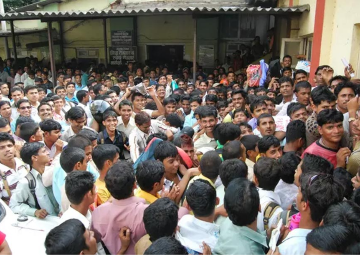
The Indian Ministry of Home Affairs, through a gazette notification on the 24 May 2019, banned terrorist outfit Jamaat ul Mujahideen Bangladesh (JMB) and all its factions. The ban comes after an alert issued by the Central Intelligence Bureau (IB) to the West Bengal government. It warned them of an attack in West Bengal, particularly in districts bordering Bangladesh, by terrorist outfit Jamaat ul Mujahideen Bangladesh, which now operates under the umbrella of the global terrorist organisation Islamic State (IS). Earlier in May, a message on a pro ISIS group on the messaging application Telegram, warning of an ISIS attack in undivided Bengal (which includes Bangladesh and the Indian State of Bengal), went viral. Furthermore, during the end of March, a Bengali magazine titled ‘Lone Wolf’, published by an agency called ‘Balakot Media’ was circulated in India and Bangladesh, encouraging Jihadis to attack India and Bangladesh. The magazine had details such as suggested targets, methods of attack, and modes of entry into India through Bangladesh, whilst successfully evading border checks. The IB alert called for the Border Security Force and other border patrols to be vigilant. However, chances are that the threat could already be present in India because of the infiltration and expanding influence of JMB militants into India from Bangladesh since before 2015. In the wake of these alerts and developments, coupled with ISIS’ loss of territory in Syria, the subsequent return of trained militants to their home countries and with the Islamic State claiming to have established a ‘province’ in India, it is worth taking a fresh look at the threat that the group poses to India and India’s preparedness to deal with it.
It is unclear why the JMB resurfaced as three separate factions after the group was presumed to be wiped out by law enforcement agencies in Bangladesh.
The Jamaat ul Mujahideen Bangladesh, although founded in 1998, came to prominence in 2005 after the group successfully carried out almost 500 near simultaneous bomb blasts in 63 out of the 64 districts of Bangladesh on 17 August 2005. These attacks came six months after the JMB was proscribed by the Khaleda Zia led Bangladesh Government of the day. After the serial blasts, the Bangladeshi government came down heavily on the JMB, eliminating most of their top leadership with the help of a dedicated counter terrorism unit aimed at tackling radical Islamist terrorism. By 2010, it was believed that the JMB had been completely eradicated, after one of their leaders, Maulana Saidur Rehman, in his confession statement claimed that their cadre strength had come down to merely 400 from a peak of 10,000 full time and almost 100,000 part time cadre. After almost 11 years of inactivity and near demise of the group, it resurrected, but not as one group. Reports suggest that the JMB broke into three separate factions. Of the three factions, the first one was of the old JMB, which was managed by Saidur Rahman while he was still in prison through his son Abu Talha, who was also arrested in July 2015. The second faction, run by Salahuddin and Zahidul Islam, was functioning out of India, and were outed when their plan to carry out large scale attacks fell through after an accidental explosion at their hideout in Burdwan in 2014. Later, these two factions reportedly merged, and were run under the leadership of Saidur Rahman from the prison as the Amir and Salahuddin as the acting Amir. However, it is the third faction, one which carried out the Holey Artisan Bakery attack in Dhaka in 2016, that was reportedly inspired/supported by the Islamic State and poses a direct threat to India and the region. Terrorist groups do not usually go underground and then come back as different factions following different ideologies. It is unclear why the JMB resurfaced as three separate factions after the group was presumed to be wiped out by law enforcement agencies in Bangladesh. A possible reason for this could be the fact that the group lacked any kind of leadership after the government crackdown that led to the arrest of its top leadership and those militants who were still free, found other radical groups to ally with, in the absence of a leader.
The presence of JMB militants in India can be attributed to the counter measures adopted by the Bangladesh government, which drove them out of Bangladesh and to the porous nature of the Indo-Bangladesh border, allowing militants to pilfer into India without much trouble. Between 2014 and 2017, more than 3,000 militants belonging to terrorist groups JMB and HUJI-B entered India through West Bengal, Assam and Tripura. The group was found responsible for the Burdwan explosion in 2014 and for the blast in Bodh Gaya, Bihar in 2018. According to reports, ever since their infiltration into India, the JMB has been expanding its presence in India’s Eastern states that share a border with Bangladesh. Investigations carried out by the National Investigation Agency (NIA) revealed that the JMB has not only found secure places to live, but have also set up recruitment camps, madrasas and training camps in areas close to the international border, as was also confirmed in the MHA notification that banned JMB. The NIA recovered IED’s, training manuals and several documents encouraging killing foreign nationals and Buddhists in India and Bangladesh in response to the atrocities against Rohingya Muslims.
The presence of JMB militants in India can be attributed to the counter measures adopted by the Bangladesh government, which drove them out of Bangladesh and to the porous nature of the Indo-Bangladesh border, allowing militants to pilfer into India without much trouble.
It is worth noting that India shares a 4,165 kms border with Bangladesh, spreading across 5 states — West Bengal (2,117 kms), Tripura (856 kms), Meghalaya (443 kms), Assam (262 kms) and Mizoram (180 kms). The ease with which the JMB is infiltrating into India, operating and expanding its footprint raises serious concerns for India’s security in particular and for regional security in the subcontinent in general. The Indian government has been committed to fighting terrorism in the hinterland and to securing its borders to minimise illegal migration of terrorists into the country. The Assam police has confirmed the involvement of JMB in five cases in which 55 cadres of the group were arrested and has also arrested 565 suspected JMB operatives in the state. Further, Bengal police arrested JMB terrorist Araful in Bangalore for his alleged involvement in the 2018 Bodh Gaya blast. He was reportedly trying to free Kausar, the JMB terrorist arrested for his role in the 2014 Burdwan explosion through existing sleeper cells. On the 26 March 2019, the ATS of the Bihar Police detained two men, allegedly associated with the JMB and IS Bangladesh (ISBD), who were in possession of Islamic State posters and documentation relating to the deputation of Central Forces in Jammu and Kashmir. The fake voter IDs and PAN cards recovered from them suggest that they entered India with the help of forged IDs. Even with regard to border management, the Indian government has set up Comprehensive Integrated Border Management Systems (CIBMS) at the Indo-Bangladesh International Border, which are aimed at all-round security of India’s international borders with Pakistan and Bangladesh with the help of technology.
While India has made efforts domestically and along with Bangladesh to counter the threat posed by the JMB in the past, it leaves much to be desired. The arrests of JMB cadres in several parts of the country and the setting up of a smart border management mechanism indicates the Indian governments’ commitment to the eradication of terrorism. However, it also suggests that movement of terrorists, after having crossed the border is relatively hassle free. Furthermore, the rough terrain of India’s international border with Bangladesh makes it difficult for border forces to prevent infiltration through irregular routes such as with the help of boats through the rivers and streams at the border. Therefore, the ability of CIBMS’s to stop illegal migration is something that will have to been seen over a period of time. The Islamic State backing to the JMB has given a massive boost to their operations in India — ideologically and logistically. The Indian government needs to have better Center-State coordination when it comes to border management to make sure illegal migration of terrorists into the country is checked and erode the conducive environment that currently exists at the border for terror groups to find haven and, with time, expand. The Indian government, along with the government of Bangladesh, needs to continue its concerted effort to eradicate the group and ensure regional security, as they have been. Further, India’s counter strategy also needs to address the ideological influence of the JMB, which they have been able to propagate through madrasas and training camps and by sending in influencers and recruiters from across the border. The fact that the JMB, along with the Islamic State has been able to expand its footprint in India despite strong national and bilateral countermeasures indicates that India needs to reassess its policy to counter the threat posed by the JMB — IS nexus in India’s hinterland and prevent them from spreading their wings. With many militants already in India, while the Home Ministry’s ban on the terror outfit is welcome, the move may be too little too late for it to be impactful given that a substantial number of militants belonging to the group have been operating on Indian soil for the past few years.
The author is a research intern at ORF New Delhi.
The views expressed above belong to the author(s). ORF research and analyses now available on Telegram! Click here to access our curated content — blogs, longforms and interviews.




 PREV
PREV

